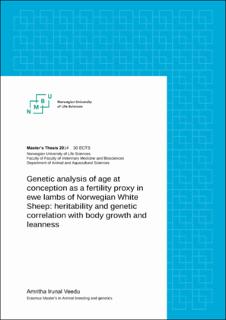| dc.contributor.advisor | Geir Steinheim and Gunnar Klemetsda | |
| dc.contributor.author | Irunal Veedu, Amritha | |
| dc.date.accessioned | 2023-11-13T17:27:32Z | |
| dc.date.available | 2023-11-13T17:27:32Z | |
| dc.date.issued | 2023 | |
| dc.identifier | no.nmbu:wiseflow:6872687:55139482 | |
| dc.identifier.uri | https://hdl.handle.net/11250/3102258 | |
| dc.description.abstract | The aim of this study was to estimate the genetic variation and heritability of ewe’s age at first
lambing (a fertility proxy) in ewe lambs of Norwegian White Sheep and to estimate the genetic
correlations between number of days till lambing and, respectively, growth rate and fat
deposition at slaughter (EUROP classification score) in half year-old ewes, utilizing data on
the ewe itself or on sibs (for fat deposition). The data of this study is from the breed Norwegian
white sheep (NWS) and was made available by Animalia. From the original dataset one dataset
was sampled containing 91683 females with weaning weight information and amongst these
31002 ewes with information for number of days at lambing. Pedigree files traced back to third
generation were used in the analysis. Age at litter, the fertility success trait showed considerable
heritability of 0.08 and had a genetic and environmental correlation of zero with the most
focused traits in the Norwegian sheep breeding program; growth rate and fat score. Therefore,
we conclude that farmers can select this fertility success trait without affecting the current
objectives of the breeding goal. On the contrary, such a strategy would make positive steps
towards economic and environmental sustainability. | |
| dc.description.abstract | The aim of this study was to estimate the genetic variation and heritability of ewe’s age at first
lambing (a fertility proxy) in ewe lambs of Norwegian White Sheep and to estimate the genetic
correlations between number of days till lambing and, respectively, growth rate and fat
deposition at slaughter (EUROP classification score) in half year-old ewes, utilizing data on
the ewe itself or on sibs (for fat deposition). The data of this study is from the breed Norwegian
white sheep (NWS) and was made available by Animalia. From the original dataset one dataset
was sampled containing 91683 females with weaning weight information and amongst these
31002 ewes with information for number of days at lambing. Pedigree files traced back to third
generation were used in the analysis. Age at litter, the fertility success trait showed considerable
heritability of 0.08 and had a genetic and environmental correlation of zero with the most
focused traits in the Norwegian sheep breeding program; growth rate and fat score. Therefore,
we conclude that farmers can select this fertility success trait without affecting the current
objectives of the breeding goal. On the contrary, such a strategy would make positive steps
towards economic and environmental sustainability. | |
| dc.language | eng | |
| dc.publisher | Norwegian University of Life Sciences | |
| dc.title | Genetic analysis of age at conception as a fertility proxy in ewe lambs of Norwegian White Sheep: heritability and genetic correlation with body growth and leanness | |
| dc.type | Master thesis | |
